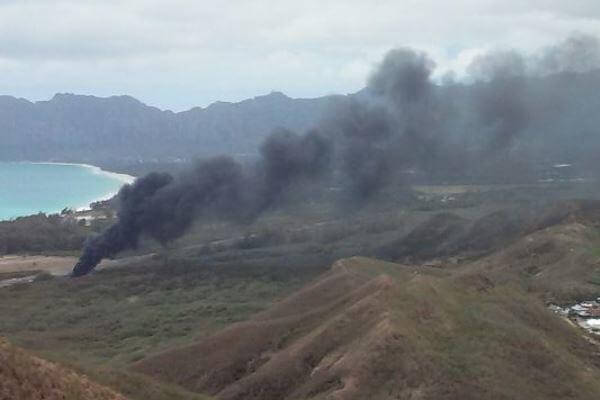"Severe brownout conditions" caused by an MV-22 Osprey's own rotor wash contributed to the crash landing of the tilt-rotor aircraft in a Hawaii training accident last May that killed two Marines and injured several others, according to the summary of Marine accident investigation released Monday.
"Pilot performance" was also a main factor in the May 17 "hard landing" of the Osprey with a total of 21 Marines and a Navy corpsman aboard at the Bellows training area on the island of Oahu during daytime in clear weather.
The two Marine pilots "did not violate any regulations or flight standards; however, pilot decision-making failed to take into account the contributory events that led to the mishap," according to the report which was signed by Lt. Gen. John A. Toolan, Jr., commander of Marine Corps Forces, Pacific.
The $70 million Osprey was destroyed in the fiery crash that killed Lance Cpl. Joshua Barron, 24, of Spokane, Wash. Lance Cpl. Matthew J. Determan, 21, of Maricopa, Ariz., died of injuries three days after the crash. Most of the others on board were injured.
The two Marines who were killed were assigned to Marine Medium Tiltrotor Squadron 161 (Reinforced) of the 15th Marine Expeditionary Unit (MEU). The MEU had been conducting final training exercises before deploying to the Middle East aboard the Amphibious Ready Group led by the amphibious assault ship Essex.
The investigation found that the pilots made several attempts to put down at LZ (Landing Zone) Gull, each time backing off in the dust and debris kicked up by the rotors which led to the brownout conditions.
Related Video:
Osprey Evolution
"A proper risk assessment should have prompted the pilots to choose an alternate flight profile, path, or landing site that would have minimized or avoided the severe brownout conditions," the report said.
In the final attempt at landing, the buildup of dust and debris on the rotor blades led to an engine failure and a loss of power "that placed the aircraft in an unavoidable free fall to the ground," the report said.
"Specifically, Engine Percent Power (EPP) decreased on both engines each time the aircraft entered a low-altitude hover over Landing Zone Gull as dust and sand particles increased in the air due to rotor wash," the report said.
"The sand and dust ingestion caused a buildup of material on the turbine blades and vanes leading to a compressor stall in the left engine, which decreased lift and resulted in the hard landing," the investigation concluded.
One of the recommendations of the report called for improving the air filtration systems on the MV-22s to avoid engine failures as a result of the aircraft's own rotor wash.
Other recommendations called for displaying engine performance and stall margins on the Multi-Functional Display in the cockpit and a "reconsideration" of procedures on flight times in brownout conditions.
When the Osprey went down last May 17, Dr. David Kaminskas was camping nearby and rushed to help. He later told Hawaii News Now that the aircraft was in flames and "I mean the munitions that were going off are like -- pow."
"One of my primary concerns was that we move the injured away from the aircraft because there was a concern the aircraft itself may explode," he said.
Following the Oahu incident, the Pentagon and the Marine Corps once again defended the safety and reliability of the Ospreys and their tilt-rotor design, noting that the aircraft had the lowest Class A flight mishap rate of all Marine rotorcraft through its 200,000 flight hours.
A Class A flight mishap is one that results in loss of life or more than $2 million in damage to equipment.
However, dozens of Marines were killed in accidents during the development of the Osprey, which began in 1982 and continued despite the efforts of then-Defense Secretary Dick Cheney to scrap the program in the 1990s.
In 1992, seven people were killed during testing when an Osprey crashed in Virginia. A crash during training in Arizona on April 8, 2000, killed 19 Marines. On Dec. 11, 2000, four Marines were killed when an Osprey crashed in North Carolina.
Overall in testing, the Osprey had a total of seven Class A accidents resulting in 36 deaths. Since becoming operational in 2007, and logging thousands of flight hours in Iraq and Afghanistan, the Osprey has had four crashes resulting in eight fatalities.
-- Richard Sisk can be reached at richard.sisk@military.com






























